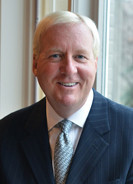What does this election cycle tell us about nonprofit fundraising?

Guest post by Jeffrey Byrne
Jeffrey Byrne, president and CEO of Jeffrey Byrne + Associates, and a Board Member for Nonprofit Connect, wrote this article on using political giving to predict philanthropic behavior. This was originally published in the "As I See It" column in the Kansas City Star on December 4, 2016.
I’m a political junkie and a fundraising nerd. My formative professional years were spent in politics. I’m now in my third decade as a fundraiser. The two sectors are more related than you might think.
No matter what side of the aisle you’re on (and even if you profess to be on neither), you’d be hard pressed to deny that this year’s election process was unlike anything we’ve ever seen. And of course, in every election, we “follow the money.” Who is giving? How much? To whom? And most important, why? We want deeper insight about the connections and agendas of candidates to predict future behavior and the ultimate impact on public policy and our lives.
As of Nov. 2, the latest prediction from the Center for Responsive Politics for the cost of the 2016 federal election is at least $6.9 billion. This figure doesn’t include political giving at state or local levels, and it certainly doesn’t include “dark money” — principally 501(c)(4)s and 501(c)(6)s that do not have to disclose their sources of funding. So my low estimate for total political giving this election cycle is $10 billion.
Now let’s analyze charitable giving. “Giving USA: The Annual Report on Philanthropy,” the seminal publication on the sources and uses of charitable giving in the U.S released every June, reports Americans gave an estimated $373.25 billion to charities in 2015. This generosity is expected to continue, as total giving in the U.S. is expected to increase by 4.1 percent in 2016. Over a two-year period, Americans will have donated roughly $750 billion to charitable causes.
Historically, charitable giving has hovered around 2 percent of the GDP. The needle never really moves (other than slightly during the 1987 and 2009 recessions). In 2015, the nonprofit sector (nonprofit institutions serving households, excluding those serving government or business) contributed an estimated $1.02 trillion to our economy. That’s roughly 5.6 percent of the GDP. We’re on track to eclipse that in 2016: Through the third quarter, the sector has already contributed the same.
So what does this dramatic election cycle mean to nonprofit fundraising?
Public policy impacts nonprofits. Recently, the philanthropic sector has been under increasing scrutiny with calls for reform. Myriad issues could impact the nonprofit community: overtime regulation, gift substantiation, charitable giving incentives/tax provisions like the IRA rollover and challenges to nonprofit tax exemptions. The philanthropic sector should always be in tune with how government might affect it.
You can also follow political giving to help predict philanthropic behavior. An analysis by DonorSearch (a donor screening service for nonprofits) of $5 billion in donations made to 400 charitable organizations reveals charitable giving is highly correlated to political giving. Someone who has given at least $2,500 in his/her lifetime to federal political campaigns is almost 15 times more likely to give a philanthropic donation than someone who hasn’t. Virtually every Federal Election Commission donor with lifetime political giving of $15,000 has made a four- to seven-figure charitable gift. Political giving is just as good an indicator of future philanthropy as any measure of wealth.
During the election, pundits were nervously asking, “Will all this political fundraising drama hurt philanthropy?” We’re already seeing numerous reports of a surge in postelection charitable giving. My estimate is that total charitable giving will be roughly 75 times that of political giving this election cycle. That’s a resounding no.
Americans give more than a billion dollars a day, on average, to help others. I am confident political giving won’t usurp charitable giving — in fact, I say “follow the money” to help strengthen philanthropy.

